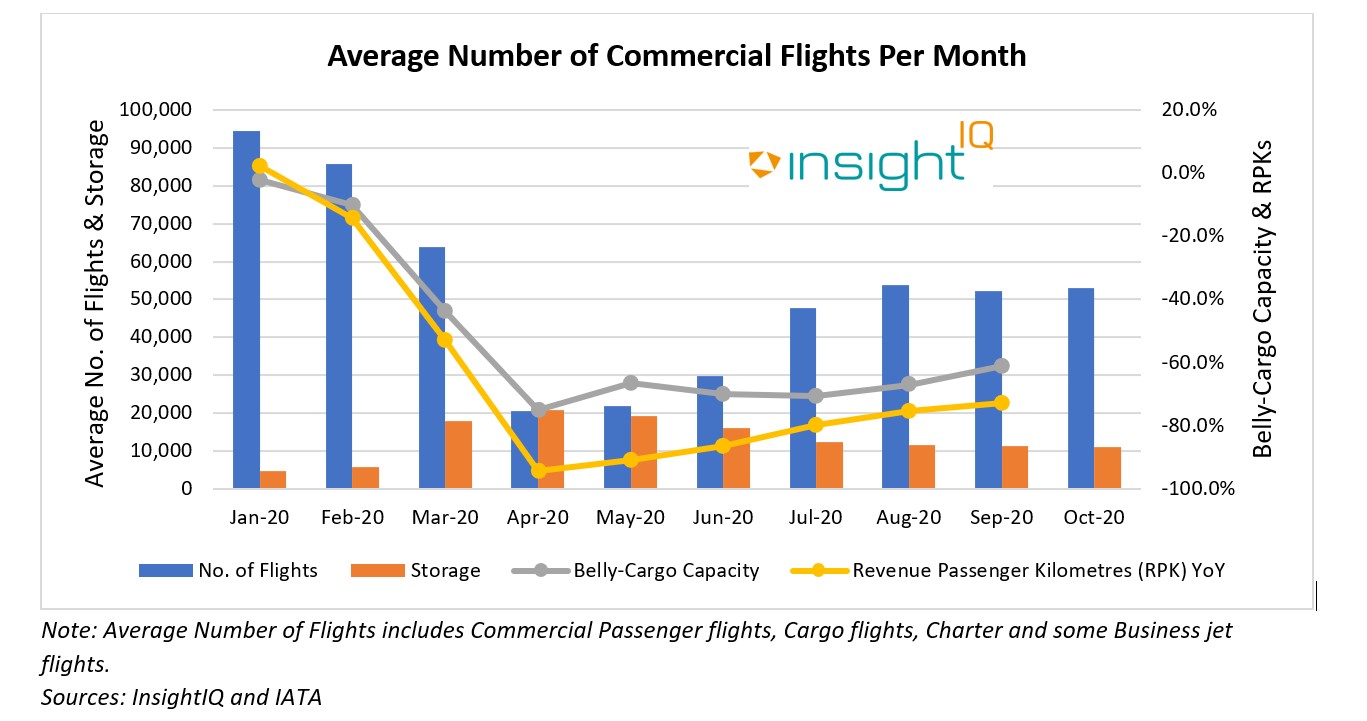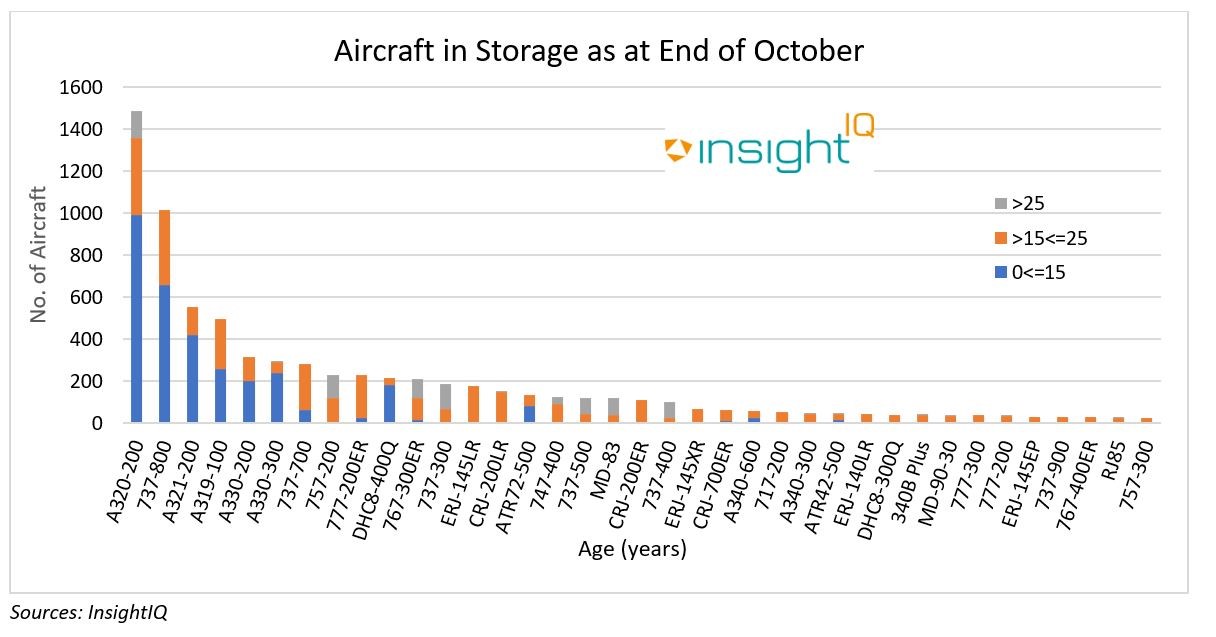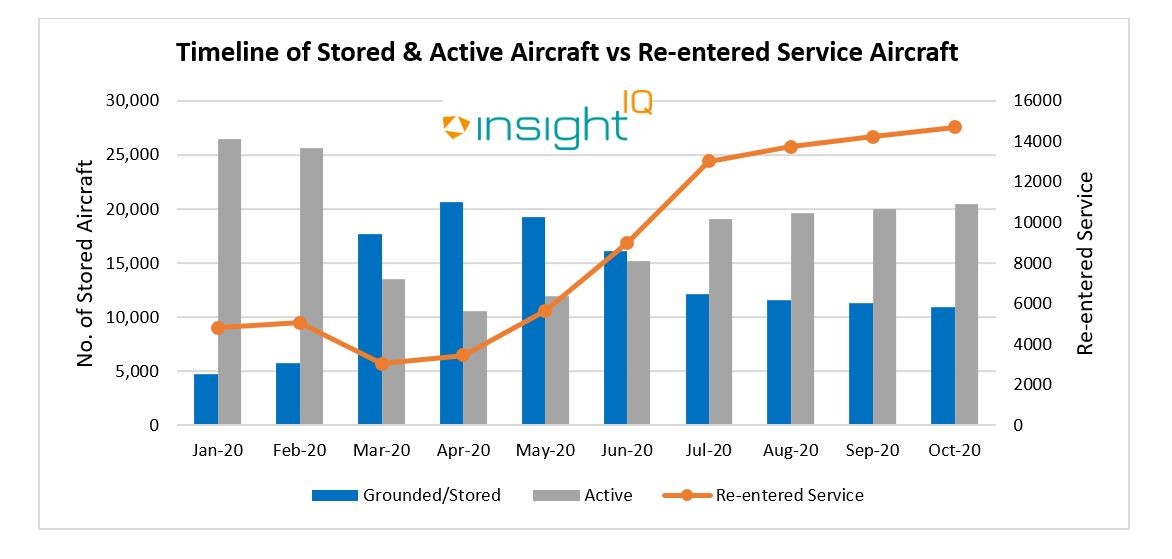18/11/2020
The shocking outbreak of the Covid-19 pandemic at the beginning of 2020 initiated events that would rock the commercial aviation industry and guarantee the restructuring of even the largest airlines.
Passenger air transport measured in Revenue Passenger Kilometres (RPKs) fell by around 53% year-on-year in March. Consequently, belly cargo capacity dropped by more than circa 43% due to worldwide flight cancellations. Despite the temporary conversion of passenger aircraft to cargo aircraft by airlines such as KLM Royal Dutch Airlines and Lufthansa amongst others, the number of flights fell by approximately 32% in March and 78% in April compared with January figures.
Using IBA's InsightIQ intelligence platform and IATA statistics, we have analysed the scale of fleet storage airlines have implemented to mitigate the pandemic's impact on air passenger and cargo traffic. For the analysis, IBA has considered passenger and freighter configuration classed under narrowbody, widebody, regional jet and turboprop. We've also identified any aircraft inactive for more than seven days as being in storage.
The major decline in traffic forced airlines to withdraw a significant portion of their fleet from service, some temporarily and some permanently, increasing the number of stored aircraft to more than 70% of the in-service fleet.

At the end of March this year as the pandemic reached its height, more than half of the global fleet was recorded as stored. The timeline above shows the increased rate of grounding from the second half of March. The Asia Pacific (APAC) region had circa 53% of its in-service fleet stored compared with Europe & CIS with about 86% and North America with 58%. The Middle East, Latin America and Africa had over 70% of their in-service fleet stored by late April. Storage levels reduced at a moderate pace throughout May and June. However, over one third of the fleets in Africa, Europe, the Middle East, Latin and North America today remain stored. Although storage is notably lower in Asia Pacific, it still represents 25% of aircraft in the region.
Sources: InsightIQ
As the road to recovery continues, IBA expects many airlines to emerge with younger fleets as they initiate fleet exit and early retirement strategies and replace older aircraft with modern assets. Aircraft such as the Boeing 757-200, 767-300ER, 737-700, 777-200ER and Embraer E145LR which are 15 years old or above are likely to face retirement and be replaced by newer, efficient models.

InsightIQ data shows more than 10,000 aircraft were still in storage as at the end of October. The resurgence of demand for domestic travel and the need to capture new markets has driven some airlines across the world to gradually but cautiously return aircraft to active service. More than 45% of the fleet in the Asia Pacific (APAC), Europe & CIS and North American regions had re-entered active service by October's close. China Eastern Airlines, Air China, Turkish Airlines, Aeroflot-Russian Airlines, Air France, United Airlines and Federal Express have all returned more than 50% of their fleet to active service. All Nippon Airways and Ryanair have returned around 70% and 95% respectively.

At the end of March this year as the pandemic reached its height, more than half of the global fleet was recorded as stored. The timeline above shows the increased rate of grounding from the second half of March. The Asia Pacific (APAC) region had circa 53% of its in-service fleet stored compared with Europe & CIS with about 86% and North America with 58%. The Middle East, Latin America and Africa had over 70% of their in-service fleet stored by late April. Storage levels reduced at a moderate pace throughout May and June. However, over one third of the fleets in Africa, Europe, the Middle East, Latin and North America today remain stored. Although storage is notably lower in Asia Pacific, it still represents 25% of aircraft in the region.
Sources: InsightIQ
As the road to recovery continues, IBA expects many airlines to emerge with younger fleets as they initiate fleet exit and early retirement strategies and replace older aircraft with modern assets. Aircraft such as the Boeing 757-200, 767-300ER, 737-700, 777-200ER and Embraer E145LR which are 15 years old or above are likely to face retirement and be replaced by newer, efficient models.
IBA's InsightIQ analysis platform flexibly illustrates multiple asset, fleet and market positions, actual and potential, to inform client choices and identify acquisition opportunities. Immediate access to crucial aircraft, engine, lease rate and fleet data eases appreciation of historic and future aircraft concentrations and operator profiles.